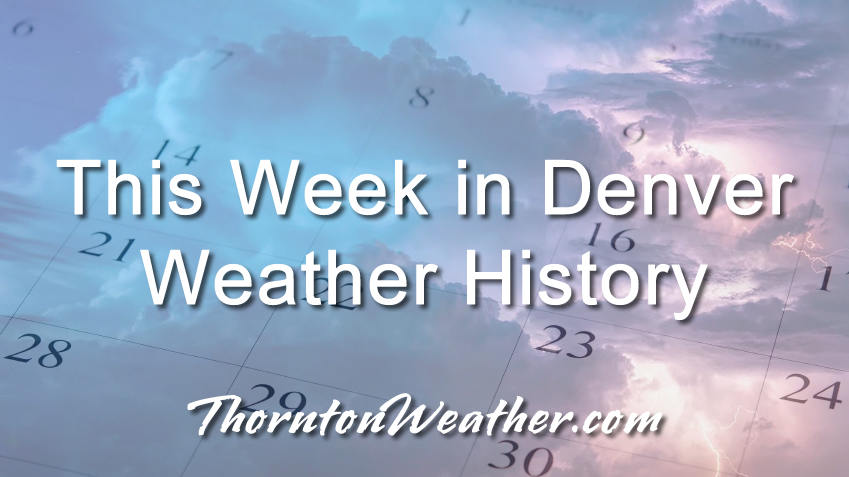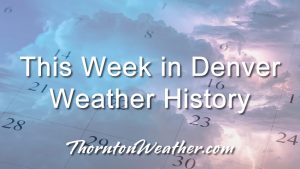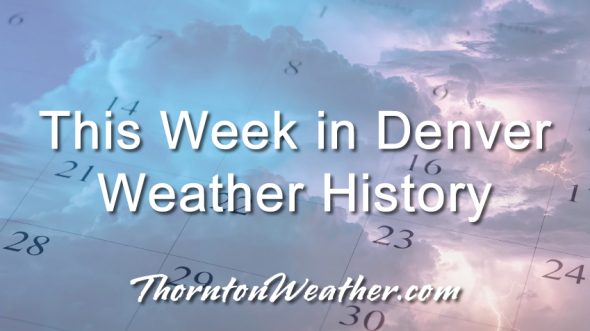
Pick your poison. Blizzards and monster snow? Tornadoes? Hail? Deadly lightning? All of the above have been seen during this week in Denver’s past.
From the National Weather Service:
18-20
In 1966…sub-freezing temperatures caused thousands of dollars in damage to fruit trees across metro Denver. Minimum temperatures were in the teens each morning and failed to reach above freezing on the 19th. The low temperature of 13 on the 20th set a new record minimum for the date. Snowfall totaled 5.7 inches at Stapleton International Airport during the period.
19-20
In 1892…rain on the 18th changed to snow on the 19th and totaled 6.0 inches over downtown Denver into the 20th. Total precipitation was 1.56 inches. North winds were sustained to 26 mph on the 19th.
In 1907…a major storm dumped 18.0 inches of snowfall in downtown Denver. Much of the heavy wet snow melted as it fell. The most snow on the ground was 7.0 inches at 6:00 pm on the 19th. North to northeast winds were sustained to 42 mph on the 19th and to 21 mph on the 20th. High temperatures were in the low to mid 30’s with low readings around 20.
In 2021…moderate to heavy snow occurred in and near the Front Range Foothills…with the heaviest amounts in and near the foothills of Boulder and northern Jefferson counties. Storm totals ranged from 8 to 16 inches in those areas…with 2 to 7 inches across the rest of the I-25 Corridor. The National Weather Service Office in Boulder measured 8.9 inches…with a measurement of 3.1 inches of snowfall at Denver International Airport.
19-21
In 1984…a large snowstorm buried most of Colorado under a thick mantle of wet snow. Total snow amounts ranged from 10 to 20 inches across metro Denver and a whopping 20 to 40 inches in the adjacent foothills. The snow closed roads and damaged electrical transformers…causing numerous power outages. Nearly 14 inches (13.6) of snow fell at Stapleton International Airport where the combination of snow and wind closed all but one runway…resulting in the cancellation of many flights. Both I-70 and I-76 were closed to the east of Denver.
19-22
In 1933…a major storm dumped 16.8 inches of snowfall over downtown Denver when rain changed to snow during the early morning of the 20th and continued through midday of the 22nd. Most of the snow fell on the 21st. Due to melting… The most snow on the ground was 10.5 inches at 6:00 pm on the 21st. Before the snow started…a strong cold front on the evening of the 19th produced north winds sustained to 35 mph with gusts to 37 mph. The strong winds deposited a thin layer of dust on the city. North to northwest winds were sustained to 31 mph with gusts to 35 mph on the 20th and to 29 mph with gusts to 32 mph on the 21st.
20
In 1874…light snow fell for most of the day…but melted almost as fast as it fell. The flakes…as large as 1 1/2 inches in diameter during the afternoon…resembled white feathers. Precipitation from melted snow was only 0.21 inch in the city. Snowfall was much heavier in the mountain parks where snow depths were reported between 3 and 5 feet from the storms of the 15th and 20th. The heavy snow resulted in the deaths of hundreds of cattle and sheep.
In 1875…the city was enveloped in a severe wind and sand storm. For nearly 30 minutes before the storm…it could be seen moving toward the city from the northwest as a black wall of clouds extending only 10 degrees above the horizon. At 5:30 pm…the sand was sweeping past in such clouds that objects at a distance of only 10 yards were not visible. The streets were entirely deserted. The greatest velocity of wind during the storm was 36 mph from the north-northwest. The storm diminished by 7:00 pm. Swarms of grasshoppers were seen today and were reported in all parts of the territory.
In 1897…southwest winds were sustained to 46 mph with gusts to 50 mph. The apparent Chinook winds warmed the temperature to a high of 76 degrees.
In 1905…apparent post-frontal north winds were sustained to 43 mph.
In 1912…west winds were sustained to 42 mph with an extreme velocity of 48 mph.
In 1958…strong Chinook winds gusted to 52 mph at Stapleton Airport.
In 1981…3/4 inch hail fell in Lakewood with up to one half inch of rain in a few minutes across northern sections of the city of Denver. Thunderstorm rainfall totaled 0.39 inches at Stapleton International Airport…where 1/4 inch hail was also measured.
In 1987…6 to 12 inches of heavy snow fell in the foothills. Only 2.5 inches of snow fell at Stapleton International Airport where the usual flight delays occurred.
In 2005…severe thunderstorms produced large hail across metro Denver. Hail as large as 1 3/4 inches in diameter fell at Denver International Airport. Hail to 3/4 inch in diameter fell in and near Golden and near Hudson… Keenesburg…Barr Lake…and Bennett.
In 2013…an avalanche pushed a group of six snow boarders into the Sheep Creek Gully of Loveland pass. This is near but outside the Loveland Ski Area boundary. Five of the six members of the group died as they were completely buried. The avalanche is the deadliest in Colorado since 1962 when seven people were killed when a slide buried residents at twin lakes near independence pass.
20-22
In 1957…strong and gusty south to southeast winds raked metro Denver each day. The strongest wind gust of 55 mph occurred on the 21st when blowing dust briefly reduced the visibility to 3/4 mile at Stapleton Airport.
20-23
In 1989…unusually warm weather resulted in several daily temperature records being broken in Denver. The high temperature of 89 degrees on the 21st exceeded the record maximum for the month at that time. Daily record high temperatures were either exceeded or equaled with 83 degrees on the 20th…88 degrees on the 22nd…and 85 degrees on the 23rd. The low temperature of 55 degrees on the 22nd equaled the record high minimum for the date.
21
In 1885…rain changed to snow during the early morning and was the heaviest snow of the season. Total snowfall was estimated at 8.0 inches over downtown Denver…but the snow melted rapidly on the ground as it fell. However… The weight of the snow…as well as northwest winds sustained to 29 mph downed telegraph and telephone wires. Several large branches of trees were also broken by the weight of the snow. Precipitation totaled 1.01 inches from the storm.
In 1887…west winds were sustained to 47 mph.
In 1932…the temperature dipped to a low of only 60 degrees… The all-time record high minimum for the month.
In 1988…a small tornado was observed by National Weather Service employees about 3 miles northwest of Thornton. It was on the ground for about 2 minutes. No damage was reported. Later…lightning struck two 14-year-old girls on a softball field in Westminster. One was killed…while the other suffered moderate injuries. Northwest winds gusted to 44 mph at Stapleton International Airport behind a cold front.
In 2010…severe thunderstorms produced large hail…strong winds and a tornado across parts of Adams…Arapahoe… Elbert…and weld counties. The hail…up to 1.50 inches in diameter…came down so heavy along parts of I-70 and I-76 that snowplows had to be called out to remove it. Numerous vehicles were damaged by hail. In weld County…very heavy rain and hail accompanied thunderstorm winds up to 75 mph. Hail up to 1.50 inches was reported near Bennett; 1.25 inches…5.3 miles east of Englewood; 1.0 inch size hail near Buckley Field; with 0.88 inch size hail near Boulder. A weak tornado touched down briefly in Elbert County…about 9 miles southwest of deer trail…but did no damage. Several minor accidents were reported with snowpacked and slick road conditions along with very low visibilities. Minor street flooding was reported in southeast Aurora. Denver International Airport recorded 0.30 inches of rainfall. Also…a peak wind gust to 36 mph from the southeast was observed at the airport.
21-22
In 1910…north winds were sustained to 45 mph behind a cold front. Rainfall totaled 0.63 inch.
In 1923…snowfall of 2.0 inches in the city was the only snow of the month and the last measurable snow of the season. Northwest winds were sustained to 25 mph on the 21st.
In 1952…heavy snowfall totaled 7.6 inches at Stapleton Airport. The storm was accompanied by north winds gusting to 33 mph.
In 2001…the second major snow storm in 11 days moved into metro Denver with blizzard conditions developing again across the plains to the northeast of Denver. Snowfall amounts ranged up to 9 inches in metro Denver with up to 23 inches in the foothills. Northwest winds were sustained at 20 to 30 mph with gusts as high as 36 mph at Denver International Airport which was again shut down for nearly an hour by power outages on the 22nd. The outages affected lighting in the concourses…train operations…de-icing and refueling operations…flight information displays…and security screenings. Navigational aids were also affected… Resulting in the cancellation of 58 arriving and departing flights which stranded about 5000 passengers. Across metro Denver storm totals included: 9 inches at Eldorado Springs; 7 inches in Boulder; 6 inches at Ken Caryl…Northglenn and near Sedalia; and 5 inches in Arvada and Morrison. Only 1.7 inches of snow were measured at the site of the former Stapleton International Airport. In the foothills snow totals included: 23 inches near Fritz Peak south of Rollinsville…17 inches near Jamestown…16 inches near Blackhawk…14 inches in Coal Creek Canyon…13 inches at Idaho Springs and near Nederland…11 inches at Aspen Springs…and 10 inches near Bergen Park.
Continue reading April 20 to April 26: This Week in Denver Weather History


